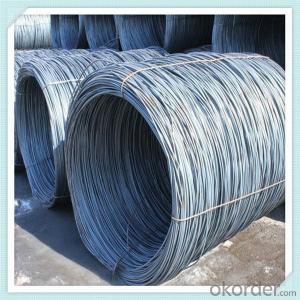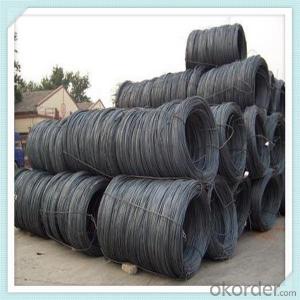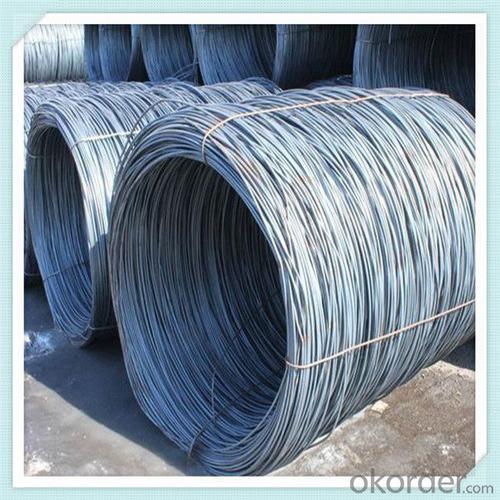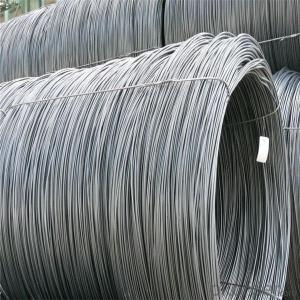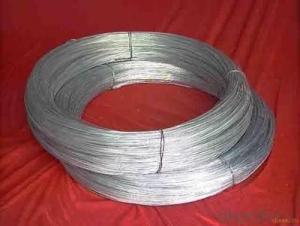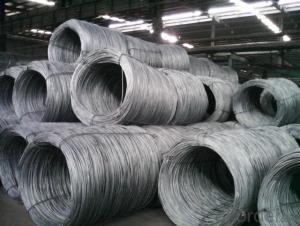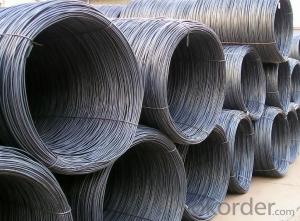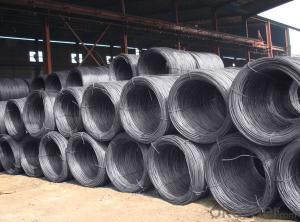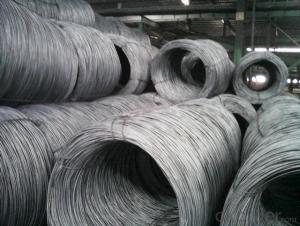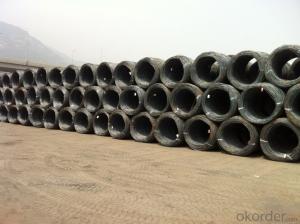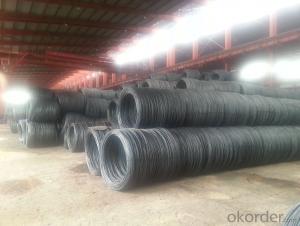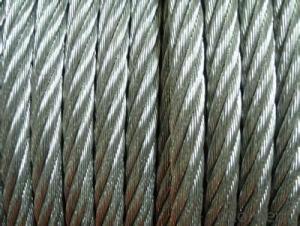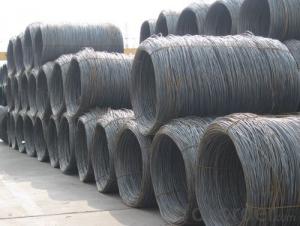SAE1018 Steel wire rod good quality for constraction
- Loading Port:
- China main port
- Payment Terms:
- TT OR LC
- Min Order Qty:
- 100 m.t.
- Supply Capability:
- 15432 m.t./month
OKorder Service Pledge
OKorder Financial Service
You Might Also Like
Specification
Features
1、Pure steel quality, stable chemical contents, small tolerance.
2、Constant Quality, good drawing performance.
3、High dimension accuracy degree, accuracy degree of Level C up to 80%, smooth surface, less scale,
easy to be pickled.
4、Automatic bundling with 4 lines by Machine in tidy and good looks
5、Big high quality percentage, small coil percentage, and heavy coil weight for Hard Coil.
6、High sorbitizing percentage.
Product Description :
Standard | AISI, ASTM, BS, DIN, GB, JIS |
Material/steel grade | Q195-Q235,SAE1006B,SAE1006CR, SAE1008B, SAE1008CR, SAE1010B, SAE1018B, or according to customers requirements |
Wire Gauge | 5.5-12mm |
Coil weight | 1.8-2.1mts |
MOQ | 25MT |
Delivery Time | 15-30 days after receipt of L/C or deposit by T/T |
Packing | In coil and load in container, if large quantity, by bulk vessel; Can be packed as customers' special requirements |
Payment terms | 1).100% irrevocable L/C at sight. 2).30% T/T prepaid and the balance against the copy of B/L. 3).30% T/T prepaid and the balance against L/C |
Application | widely used in machinery parts, manufacturing industry, electronics industry, metal tools and others |
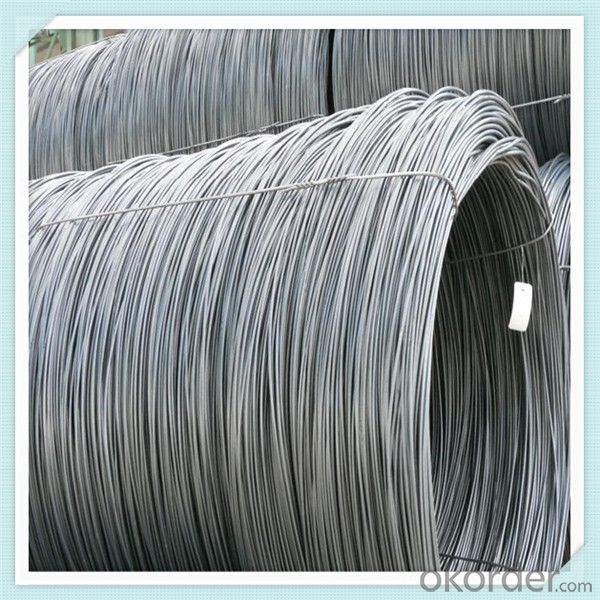
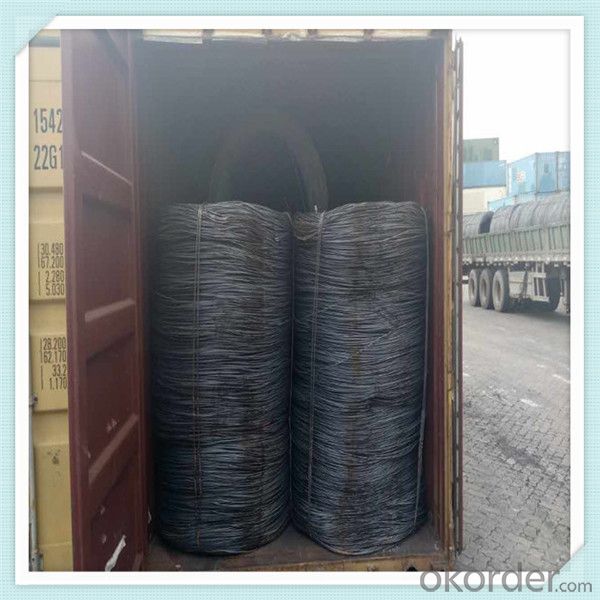
Application :
It generally used in braiding the hose for bathing product and machinery. With it
good flexibility, resistant to high temperature and resistant to corrosion, it
used widely in many industries.
Packing :
Hot-rolled wire rod is held in a unit with at least four steel straps in the
transverse direction and transported and stored without further packaging.
Before
the steel strapping is applied, the wire rod must be sufficiently compressed.
The strapping is fixed in the transverse direction with a single circumferential
strap so that the strapping does not slip and cause the coil to come apart.
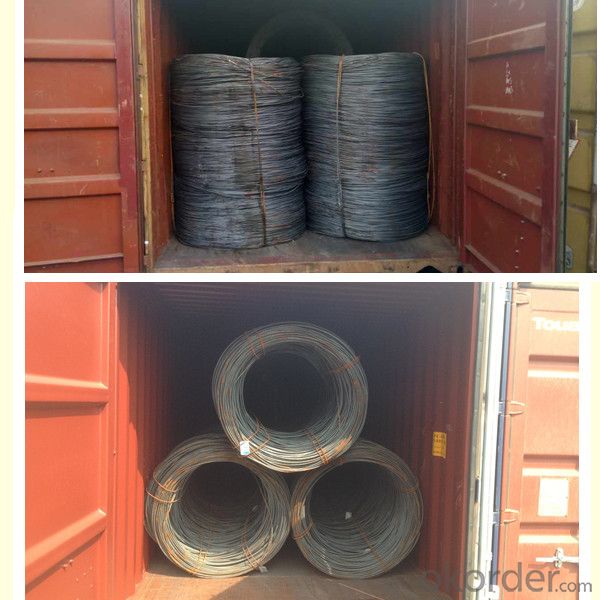
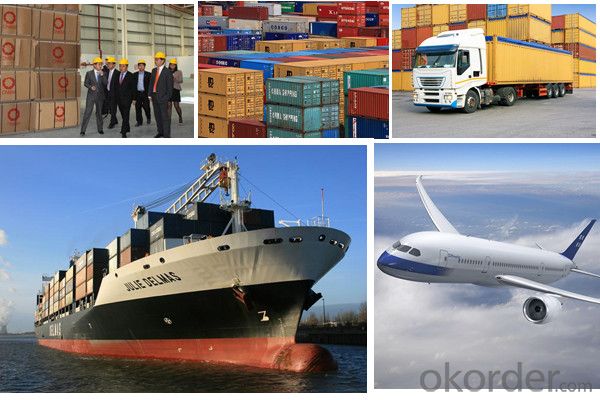
Our service:
(1) We cooperate with famous factories with advanced equipment and well trained workers.
(2) We can provide factory price with trading company service.
(3) We continuously work on the improvement of our processes, guaranteeing
consistently high standards of quality to keep none compensation.
(4) We guarantee 24 hours response and 48 hours solution providing service.
(5) We accept small order quantity before formal cooperation.
(6) We deliver the agreed quality at the agreed time, reacting to changes in
customer wishes in a flexible way.
(7) Due to our volume and selling power, we have excellent freight rates with
shipping lines.
(8) We strive to always be fair and honest in our dealings with customers.
(9) We strive to work together with customers to achieve much more than we can
achieve alone.
(10) Through our passion and commitment we aim to be a market leader in all our
key markets. To maintain our position as market leader we must continue to add
value in all that we do.
FAQ:
1.Q: What's your MOQ(minimum order quantity)?
A: One full container, mixed acceptable .
2. Q: What's your packing methods?
A: Packed in bundle or bulk ..
3. Q: How can I buy CNBM products in my country?
A:Please send us an inquiry or email ,we will reply to you if there is distributor in your country
4. Q: Can we visit your factory?
A: Warmly welcome. Once we have your schedule, we will arrange the
professional sales team to follow up your case.
5. Q: How long does it take to get the product if i place an order?
A:With the process of your requirements,we will pack and deliver in 3
-7 days. If it is by sea shipment,it will take 15-45 days depending on different locations
- Q: What are the different types of steel wire rod finishes for improved lubricity?
- There are several types of steel wire rod finishes that can be used to enhance lubricity. Some common finishes include zinc coating, phosphate coating, and galvanization. These finishes help to reduce friction and improve the smoothness of the wire, making it easier to handle and process.
- Q: What are the different types of steel wire rod coating thicknesses?
- Depending on the specific application and requirements, there are various options available for coating thicknesses in steel wire rods. Some commonly used coating thicknesses are as follows: 1. Light Coating: This coating type involves the application of a thin layer of protective material on the steel wire rod. It offers minimal protection against corrosion and is suitable for environments or conditions that are not too harsh. 2. Medium Coating: With a thickness greater than that of a light coating, the medium coating provides a moderate level of protection against corrosion and other environmental factors. It is often chosen for applications where the wire rod may be exposed to moderate levels of moisture, chemicals, or abrasion. 3. Heavy Coating: A thicker layer of protective material is applied to the steel wire rod in this case. The heavy coating offers enhanced protection against corrosion, abrasion, and other harsh conditions. It is commonly used in applications where the wire rod will be exposed to extreme environments, such as marine or industrial settings. 4. Galvanized Coating: This type of coating involves the application of a layer of zinc on the steel wire rod. It provides excellent protection against corrosion and is commonly used in outdoor applications where the wire rod will be exposed to moisture and other environmental factors. When selecting the appropriate coating thickness for steel wire rod, it is essential to consider the specific requirements of the application. Factors such as the expected level of exposure to moisture, chemicals, abrasion, and temperature variations should be taken into account to ensure optimal performance and longevity of the wire rod.
- Q: How is steel wire rod tested for mechanical properties?
- Mechanical properties of steel wire rod are assessed using a series of standardized tests that evaluate its strength, toughness, hardness, and other important characteristics. These tests are necessary to ensure that the wire rod meets the required quality standards and can be utilized in different applications. The tensile test is one of the main tests conducted on steel wire rod. In this test, a sample of the wire rod undergoes a gradually increasing load until it reaches its breaking point. During this process, the elongation and reduction in cross-sectional area of the wire rod are measured, enabling the calculation of significant mechanical properties such as ultimate tensile strength, yield strength, and ductility. Another commonly performed test is the hardness test, which determines the wire rod's ability to resist indentation or scratching. Various methods, including the Rockwell, Brinell, and Vickers hardness tests, are used to measure hardness. These tests provide information on the wire rod's capacity to withstand deformation and resist wear under different conditions. Furthermore, the impact test is conducted to evaluate the wire rod's ability to absorb energy and withstand fracture under high-stress conditions. This test involves striking the wire rod with a pendulum or falling weight and measuring the energy absorbed or the amount of deformation caused by the impact. Additional tests may involve bend tests, where the wire rod is bent to a specified angle without breaking, and torsion tests, which assess its resistance to twisting or rotational forces. It is important to note that these tests are typically carried out in accordance with internationally recognized standards such as ASTM or ISO. These standards provide guidelines for sample preparation, testing equipment, and reporting of results, ensuring consistency and comparability of test data across different manufacturers and laboratories. Overall, the testing of steel wire rod for mechanical properties is vital in guaranteeing its quality, dependability, and suitability for various applications in industries such as construction, automotive, and manufacturing.
- Q: What are the different tensile testing methods for steel wire rod?
- Some common tensile testing methods for steel wire rod include the straightening and tensile testing method, the axial tensile testing method, and the wire drawing tensile testing method.
- Q: How is the tensile strength of steel wire rod tested?
- The tensile strength of steel wire rod is typically tested using a method called the tensile test or the tension test. This test is performed to determine the maximum load or force that the wire rod can withstand before it breaks or fails under tension. In the tensile test, a representative sample of the steel wire rod is prepared by cutting it into a specific length. The sample is then placed in a testing machine called a tensile testing machine or universal testing machine. This machine consists of two jaws, one stationary and one movable, which grip the ends of the wire rod securely. Once the sample is properly positioned in the testing machine, the movable jaw is pulled away from the stationary jaw, exerting a gradually increasing force on the wire rod. The machine measures the force applied to the sample and simultaneously records the resulting elongation or deformation of the wire rod. During the test, the force and the elongation are continuously monitored until the wire rod fractures. The maximum force applied just before the fracture occurs is recorded as the tensile strength of the steel wire rod. This tensile strength value indicates the maximum load or stress that the wire rod can endure without breaking. To ensure accurate and reliable results, multiple samples are usually tested to account for any variability in the material properties. The average of these results is then taken as the representative tensile strength of the steel wire rod. Overall, the tensile strength of steel wire rod is determined through a controlled testing process using a tensile testing machine, which measures the maximum force applied to the sample before it fractures, providing valuable information about the material's strength and performance.
- Q: What are the common methods used to protect steel wire rod from corrosion?
- There exist multiple common approaches utilized for safeguarding steel wire rods against corrosion. These approaches consist of: 1. Galvanization: By applying a layer of zinc to the surface of the steel wire rod, galvanization acts as a sacrificial anode. This implies that when exposed to moisture or other corrosive elements, the zinc layer corrodes instead of the steel. 2. Coating: Another effective method for corrosion prevention involves coating the steel wire rod with a protective layer. Various types of coatings, such as epoxy, polyethylene, or polyurethane, can be employed. These coatings establish a barrier between the steel and the surrounding environment, effectively preventing direct contact with moisture or corrosive substances. 3. Cathodic Protection: The technique of cathodic protection includes applying a direct electrical current to the steel wire rod. This current initiates a protective electrochemical reaction, effectively thwarting corrosion. Cathodic protection is commonly employed in environments with highly corrosive conditions, such as marine or underground applications. 4. Proper Handling and Storage: The correct handling and storage of steel wire rods are of utmost importance in preventing corrosion. This entails storing the rods in a dry and well-ventilated area, away from moisture or corrosive substances. Moreover, utilizing appropriate lifting and transportation methods can prevent damage to the rods' protective coatings or galvanized layer, which could lead to corrosion. 5. Regular Inspection and Maintenance: Regularly inspecting the steel wire rods for signs of corrosion and performing necessary maintenance can play a significant role in preventing further deterioration. This may involve removing any rust or damaged coatings, applying touch-up coatings, or re-galvanizing the rods if required. It should be emphasized that the selection of a corrosion protection method depends on various factors, including the specific application, environmental conditions, and budget constraints. Seeking advice from corrosion experts or engineers can aid in determining the most suitable method for safeguarding steel wire rods from corrosion.
- Q: How is steel wire rod used in the manufacturing of wire rope baskets?
- Steel wire rod is used in the manufacturing of wire rope baskets as it serves as the primary material for creating the wire ropes. The steel wire rod is first drawn into wires of the required diameter, which are then twisted and braided together to form the wire rope. This wire rope provides the structural strength and durability necessary for wire rope baskets to securely hold and transport various items.
- Q: How is steel wire rod tested for impact resistance?
- Steel wire rods are tested for impact resistance through a standardized procedure known as Charpy or Izod test. In this test, a notched sample of the wire rod is placed in a pendulum impact tester. The pendulum is then released, striking the sample and causing it to fracture. The energy absorbed during fracture is measured, indicating the material's resistance to impact. This test helps determine the robustness and durability of the steel wire rod in various applications.
- Q: What are the factors that affect the quality of steel wire rod?
- The factors that affect the quality of steel wire rod include the composition of the steel, the manufacturing process, the presence of impurities, the temperature and cooling rate during production, and the quality control measures employed.
- Q: What are the different steelmaking processes used for steel wire rod production?
- Steel wire rod production utilizes several steelmaking processes, each boasting unique advantages and applications. The primary methods encompass: 1. Electric Arc Furnace (EAF): This involves scrap steel melting via an electric arc. EAF is renowned for its ability to handle diverse raw materials and produce varying steel grades. It is an energy-efficient approach widely employed in wire rod production. 2. Basic Oxygen Furnace (BOF): The BOF process employs hot metal derived from a blast furnace and introduces oxygen to reduce impurities and regulate carbon content. BOF is acclaimed for its high production capacity and capacity to fabricate an extensive array of steel grades. 3. Continuous Casting: Following EAF or BOF refining, continuous casting solidifies the molten steel into billets, blooms, or slabs. This technique allows for uninterrupted production and is commonly applied in wire rod production. 4. Ladle Refining Furnace (LRF): LRF is frequently used in conjunction with EAF or BOF. It serves as a secondary refining process, facilitating control over steel's chemical composition and temperature. LRF guarantees enhanced quality and cleaner steel, rendering it suitable for wire rod production. 5. Microalloying: Microalloying entails incorporating minute quantities of elements like vanadium, niobium, or titanium during the refining process. This enhances the strength, toughness, and other mechanical properties of the wire rod. Ultimately, the selection of a steelmaking process for wire rod production rests on factors such as desired steel grade, production capacity, energy efficiency, and cost-effectiveness. Each process exhibits distinct advantages and is employed based on specific requirements and considerations.
Send your message to us
SAE1018 Steel wire rod good quality for constraction
- Loading Port:
- China main port
- Payment Terms:
- TT OR LC
- Min Order Qty:
- 100 m.t.
- Supply Capability:
- 15432 m.t./month
OKorder Service Pledge
OKorder Financial Service
Similar products
Hot products
Hot Searches
Related keywords
